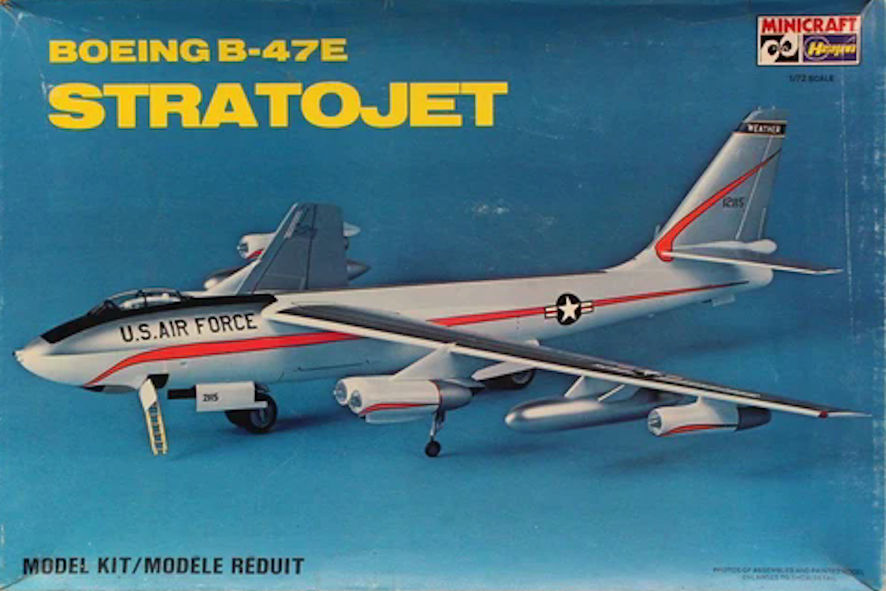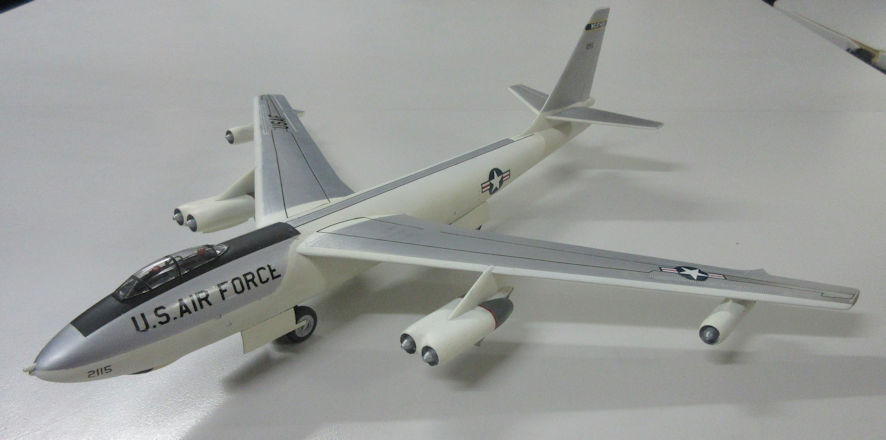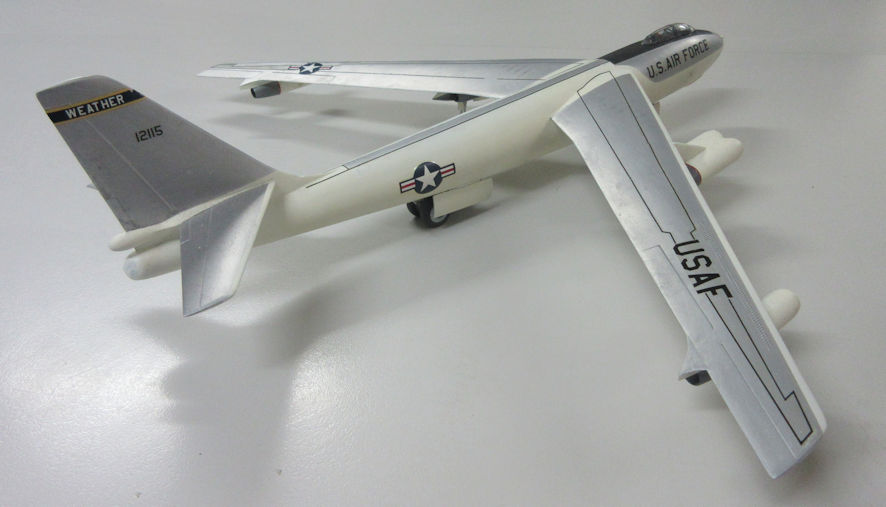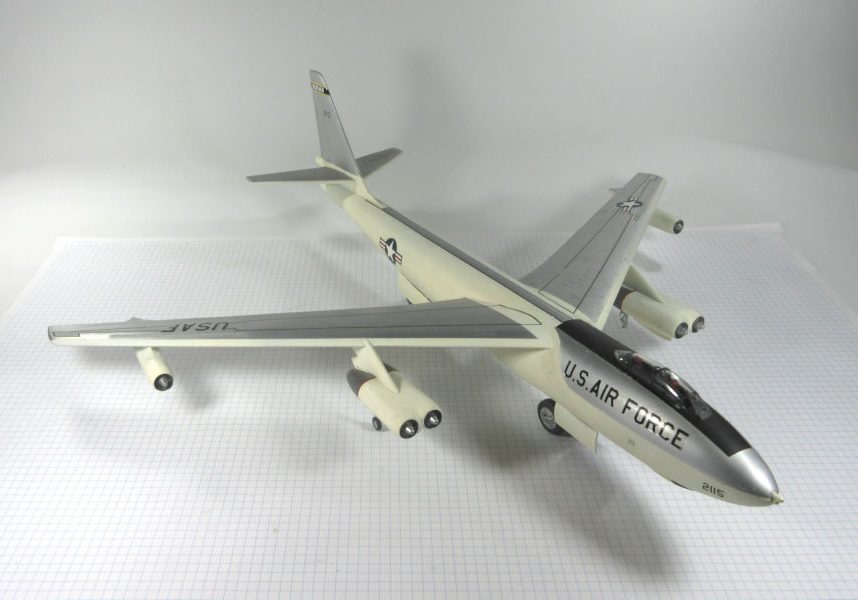Design of the first United States jet powered bombers began in 1944 but the final shape for the Boeing B-47 was only finalised after American engineers learned of German aeronautical research into swept wings. In early 1946 a contract was awarded for two XB-47 prototypes and the first one flew on 17 December 1947. Eventually over 1800 B-47s in a number of versions were constructed, the B-47B being the first production model of which 399 were constructed before production switched to the major production version, the B-47E. The B-47 remained in service until 1969.
In the early 1950s the United States Air Force began considering the idea of modifying the B-47 for weather reconnaissance and 15 late production B-47Es were converted for that purpose, fitted with a variety of air sampling and data recording equipment with a camera mounted in the nose to take photos of cloud formations. To test the feasibility of the conversion one B-47B (51-2115) was modified. It was delivered to the Air Weather Service in 1956 and first used in a hurricane research project that had been funded after disastrous hurricanes in 1954. For several hurricane seasons it flew into hurricanes and eventually logged 126.5 hours on this work. Later it went on to fly with the 55th Weather Reconnaissance Squadron before being left to the student mechanics of Air Trainining Command. The remaining WB-47Es were used for routine weather flights from USAF bases around the world until they were withdrawn from service.

Minicraft has not been one of the great names in modelling but this kit dates from the period when they were packaging kits that had been produced elsewhere. This Boeing WB-47B kit, for example, is a re-boxing of the Hasegawa B-47E, as were the old Frog and AMT kits of the same bomber. These days, however, the kit appears to be available only under the original Hasegawa brand. The Hasegawa B-47 dates from the late 1960s or early 1970s and is not bad for those days. It is not now what we would consider the perfect kit and there are plenty of details that Hasegawa would include now that it didn’t back them. Still, it is not a difficult kit to put together if you are patient and careful. When I had finished the model I discovered that the outrigger wheels were too long and had to endure surgery, but that could have been caused by my giving the model too much anhedral on the wings in the first place
I began work on this kit over five years ago but didn’t complete it. The decal sheet was so old by the time I got around to using it that the elaborate black line decals, that are an integral part of the finish of the kit, fragmented into a thousand pieces. I lost heart in the entire project and put the mess to one side with only the serial numbers in place. From time to time I cruised the internet looking for replacement decals but didn’t see anything. I also gave vague thought to buying a Hasegawa kit, removing the decals and selling the kit on at a swap meet but the kit is too expensive for that! In the meantime the almost completed model sat in its box, waiting…
The arrival of the new Academy 1/144 B-47E urged me into action, initially with the idea of using the decals in that kit as the master for something I could generate from my bubble jet printer. I had also recently put a lot of black lines on my YB-49 and was ready to use the technique again. So, with renewed enthusiasm I finally decided to finish off the old kit.
Returning to the model I was disappointed at my workmanship in many ways, particularly in the finish. All B-47s were bare metal with white anti-flash white on the undersides to ward off the effect of atomic bomb blasts. This makes it perhaps the most difficult colour scheme as getting white and bare metal to work well can cause nightmares. Looking at the work I was tempted to do it all again, but I had not forgotten the difficulties I’d had in masking the kit the first time. Once was enough so I decided to go on with what I had already done.
This led me to some research into the aeroplane I was modelling and the discovery that 51-2115 (the only decals on the kit) made it the one-off WB-47B. The Minicraft kit gives you only the decals for this aeroplane and nothing in the instructions to suggest it is unique. Neither do the instructions say that the WB-47B didn’t have tail guns and probably no under wing long range tanks (I couldn’t find a photo of any WB-47 with them). Worse, it doesn’t tell you that the WB-47B was probably the most colourful B-47 to fly, having elaborate lines and swirls of dayglo all over it by the 1960s.
The kit’s decal sheet only had a couple of dayglo lines that probably never appeared on the aeroplane, the earlier simpler markings being red. In any event, I couldn’t attempt any of these schemes unless I wanted to go back and start again because it would mean masking over metalizer, never a good idea. I also found some side view colours of it that suggested it might have had dayglo nose, tail and wingtips at some time, and that only added to the confusion. Instead of enduring endless sleepless nights about all this I reasoned that the WB-47B probably started life without any of the elaborate colour schemes so, if you ask me, I’ll tell you that this model represents the WB-47B at the beginning of its career.
The end result is a big reasonable looking model that conveys something of the slim and graceful lines of the B-47. It’s not a great bit of work but at least it is now finished.


Leigh Edmonds
July 2002
